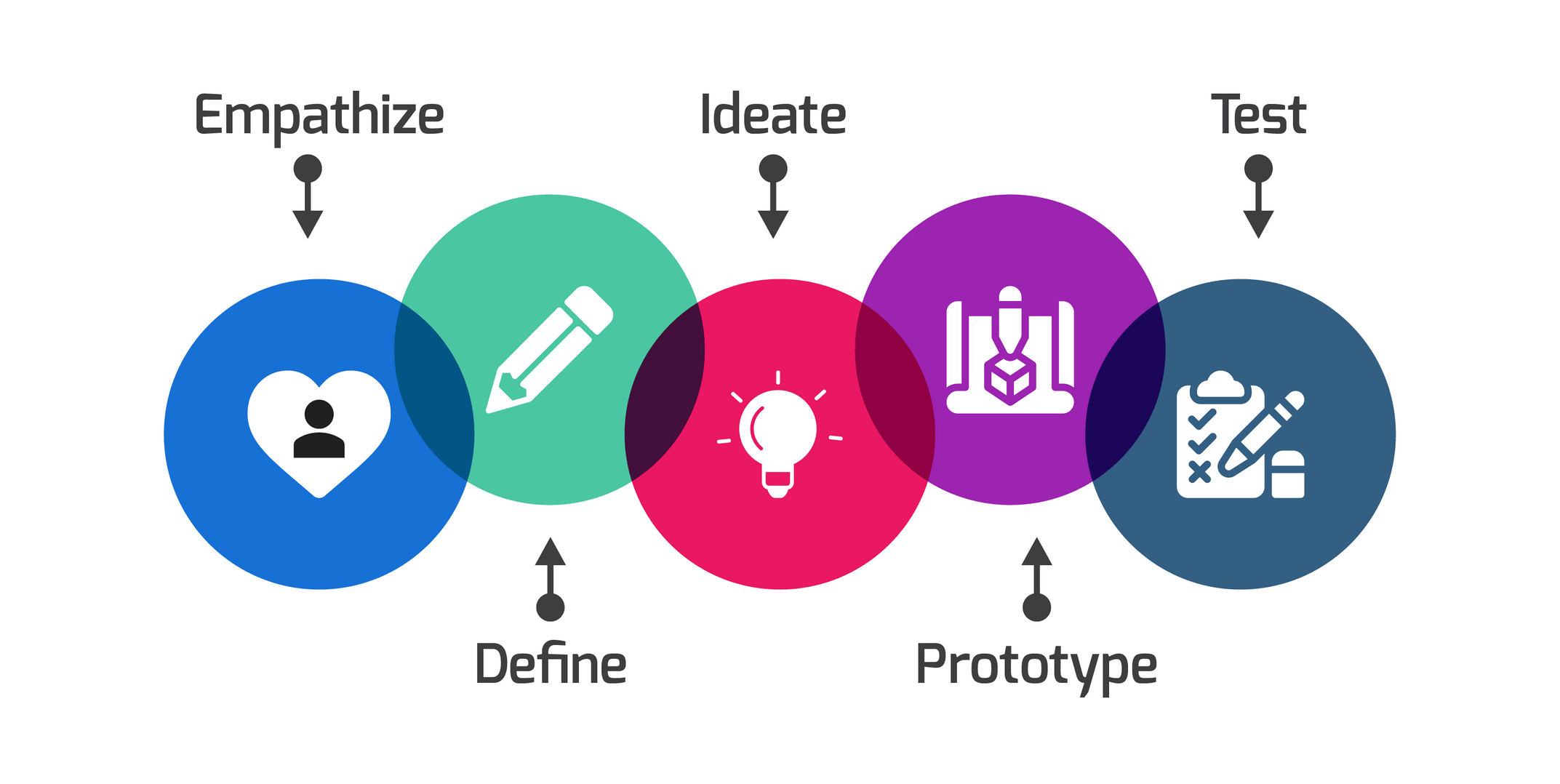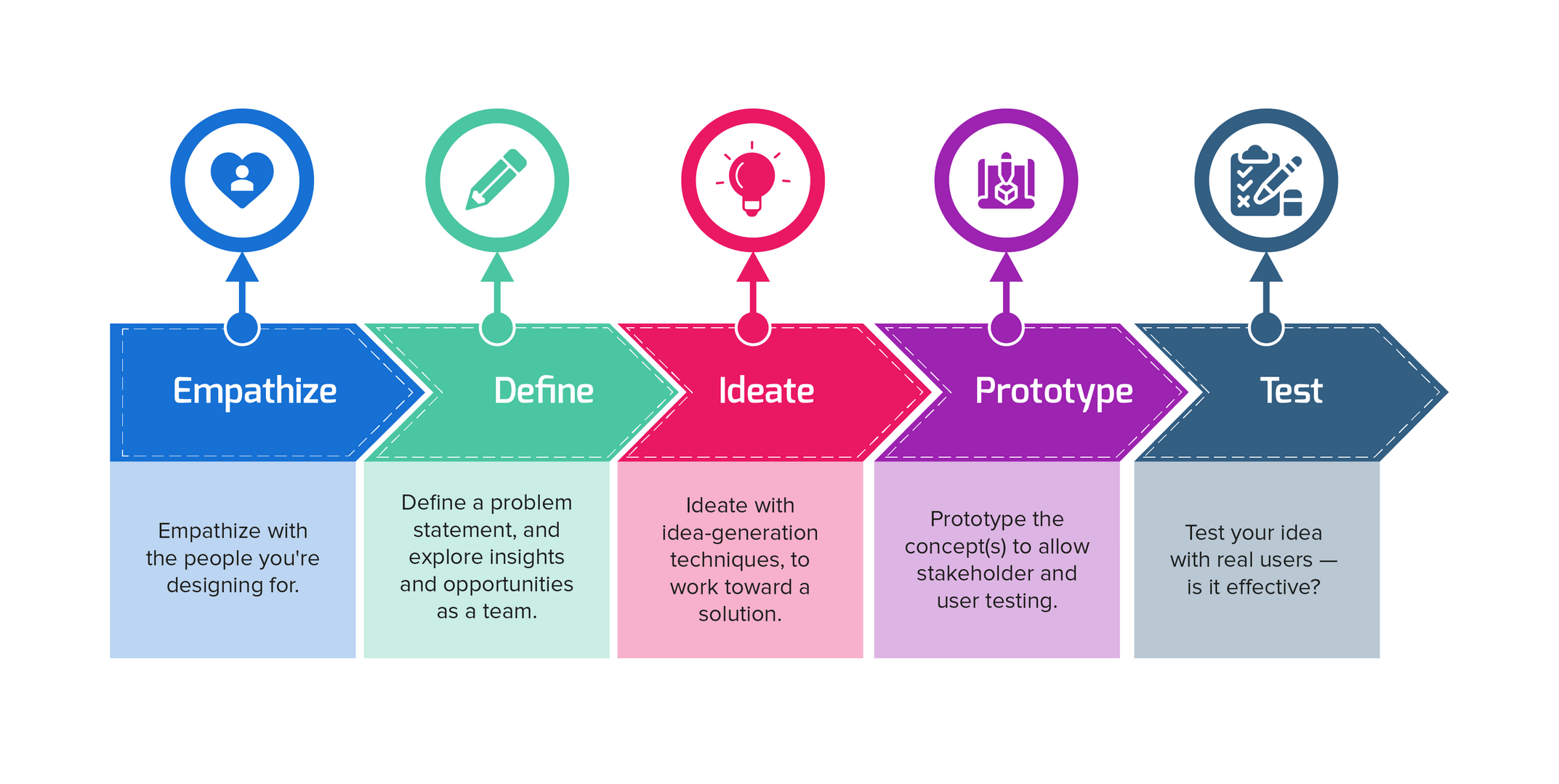Design Thinking: a tried-and-tested method
for putting your customers first

Don’t let the name fool you: design thinking isn’t some specialist skill, saved for designers and creative types alone. Design thinking exercises can be used by any business facing creative challenges and/or seeking to understand, and satisfy, their customers on a deeper level.
So what is the design thinking process? And how can you inspire design thinking in your team? Getting started is easier than you may think, and we’ve compiled everything you need to know right here.
What is design thinking?
This name can be understandingly confusing, especially if you’re learning about design thinking for the first time. So let’s demystify the “design” part of design thinking.
While design thinking as a process has its roots in the industrial and product design scene of 1960s America, it’s really just a way for anyone to see, approach, and tackle a problem in a new and innovative way. Falling under the umbrella of “user centered design”, design thinking exercises challenge the team, or individual, to view a problem through a user’s eyes.
What’s more, design thinking is an iterative process — meaning it progresses in stages, with many opportunities to pivot, adapt, and evolve based on what you’ve learned so far.
As we’ll see in a moment, design thinking can be broken down into 5 key stages — from first empathizing with the user and their needs, all the way to testing concepts and ideas in the real world. This means that any idea that makes it through the entire design thinking journey — reaching a market launch — has been explored, improved and stress-tested in a hands-on and user-centric way. In short, design thinking is one of the best ways to guarantee that your concept meets user needs.
Where did design thinking come from?
No-one knows exactly where design thinking came from, although the very origins of the movement can be traced back to Buckminister Fuller’s 1950s Design Science approach at MIT, and industrial design of a similar era, as mentioned above.
Today, though, design thinking is used in companies from many sectors all over the world — including at tech giant IBM. Global design agency, IDEO, are often associated with creating a modern take on design thinking — one that teams beyond product design and engineering could use, too.
According to IDEO, their approach combines inspiration from designer and scholar Richard Buchanan and his “wicked problems”, whereby complex challenges are made far more achievable by collaborating with key stakeholders, working in continuous feedback loops, carrying out multiple iterations, and visualizing the output every step of the way.
And with that in mind, let’s look at the 5 stages of the design thinking process.
Design thinking in 5 steps
While design thinking is an iterative process — and you may return to Step 2, after Step 4, for example — it can be mapped out in 5 key stages:
Empathize
Define
Ideate
Prototype
Test
Let’s take a look at each step more closely.
Empathize:
By exercising empathy, we understand others’ needs from our own. This requires an open mind, a willingness to think differently, and a lot of research into what consumers actually need help solving. Maintaining this empathy throughout the entire process is the essence of what design thinking encompasses.
Tools like empathy maps can help teams to really explore a user’s wants and needs — seeing the world, and the problem in question, from the customer’s viewpoint. Simply put: the more you empathize, the better you understand your user. And the better you understand your user, the easier is it to define and solve their problem(s).
Define:
In the ‘define’ stage, it’s time to put your user insights to work. You should apply what you’ve learned about the customer, to create a clearly-worded (yet inspiring) problem statement.
This mission or manifesto should be user-centered, of course. So rather than focusing on the impact for the business (increasing sign-ups, boosting revenue, etc), you should focus on the end user and what they stand to gain. This could be anything from learning healthy recipes to feed the family, to having a secure place to save their favorite digital photos.
Ideate:
So you’ve defined the problem and have an in-depth understanding of what the users need help with. Now you need some answers. No more speculation — it’s time to come up with something tangible!
The ideation stage marks the transition from identifying problems to exploring solutions.
Don’t restrict yourself to a single idea, either. With a selection of concepts, you’ve got more opportunities to test, greater chance of finding a solution that checks all the boxes, and deeper insight into what works and what doesn’t.
Prototype:
Here’s where the ideas take physical form, and where your design thinking starts to take shape. A prototype is a rough simulation or sample version of your idea — maybe it’s a wireframe of a website, or a paper prototype of an app. Either way, it’s low cost and quick to pull together (and you’ll see why that’s important soon).
It’s in this stage that you’ll first share your ideas with real end users. With a physical manifestation of your concept in-hand (literally!), your customers will be able to interact with your idea, test its usefulness, and give you invaluable feedback for improvements. You can also test your prototype with other stakeholders, if you wish.
Sometimes you’ll be told to go back to the drawing board (or Step 1 in the design thinking process) — and that’s okay. It’s better to know now if you’ve misunderstood users’ needs, than once you’ve invested more time and money in taking a concept to launch.
Test:
Even when your concept is met with widespread praise at the prototype stage, there’s one more hurdle to overcome: testing.
Here, you’ll have developed your successful prototype into a finished article. And it’s time to make sure it’s totally market ready — but your ‘design’ thinking isn’t over yet. Even in final test sessions, you can be learning from the data you collect; improving, tweaking and repositioning the solution, making it the best it can be.

Effective design thinking exercises to try today
Ready to get started with design thinking?
These are our favorite design thinking exercises, perfect for any team with any problem to solve:
- Rose, Bud, Thorn: In this exercise, The Rose represents a positive or proud moment, The Bud an opportunity for improvement, and the Thorn a cause for concern. This model helps teams work better with each iteration.
- Hope and Fears: For this task, participants write down what they hope from the future of the project and also what they’re anticipating as a challenge. By reviewing what went well last time, and what could go better the next, teams can continually improve their ways of working.
- 5 Whys: “Why” is the most important question in design thinking. Using the 5 Whys, teams can get to the core of any problem, by drilling down to the real root cause — and that’s design thinking at its best!
When to use design thinking exercises
The design thinking process can be used whenever you’re faced with a complex, user-centered challenge.
This could be deciding on a lead message for a new marketing campaign, re-structuring your website for better navigation, or redesigning the layout of your retail store — the list goes on.
